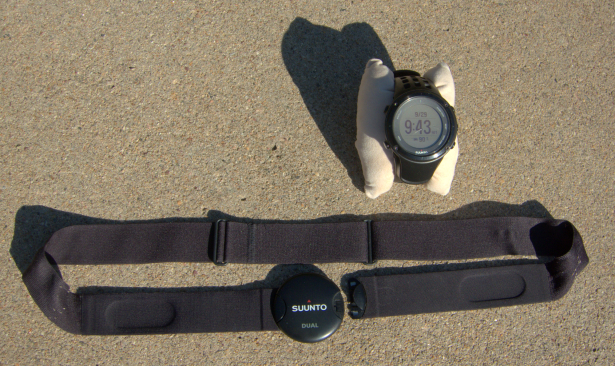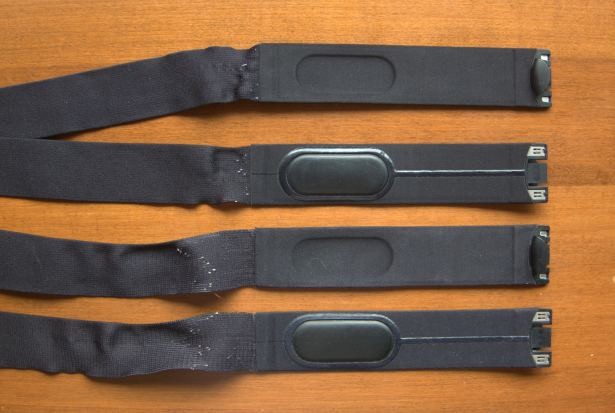
My Suunto Ambit2 and paired Dual Comfort Belt, which allows me to train based on effort (as measured by heart rate) instead of just pace.
About six months after I began using my Suunto Ambit GPS watch, I bought the paired Dual Comfort Belt so that I could train based on effort, as measured by heart rate. After 18 months of nearly daily use, and now on my second strap and third battery, I feel confident in offering a long-term review.
The value of heart rate
Before addressing the Dual Comfort Belt specifically, I want to briefly discuss the value of heart rate data. As an ultra runner who trains at altitude primarily on mountainous trails, I personally find heart rate to be a more valuable data point than my pace, which fluctuates wildly based on the trail’s slope angle. I use heart rate mostly to exert discipline:
- By capping my heart rate on a run, an easy day remains easy; and,
- By capping my heart rate early in a race or long run, I avoid depleting myself prematurely and slowing down dramatically later.
I seldom do tempo runs, but on those occasions I have used heart rate to ensure that my effort was hard enough. For example, I’ll let my HR climb into the low-160’s and then keep it there for an hour.
Compatibility
Suunto offers three heart rate belts, each with different compatibility:
- Smart Belt, for Suunto Ambit3 watches and bluetooth-enabled devices like your smartphone;
- Dual Comfort Belt, for pre-Ambit3 watches and non-GPS Suunto HR watches, plus compatible gym equipment like treadmills and stationary bikes; and,
- ANT, also for pre-Ambit3 watches and non-GPS Suunto HR watches, but not gym equipment.
Buy accordingly.
Comfort
On a man especially, the Dual Comfort Belt looks odd and dorky. You might hesitate before running shirtless; since I wear a shirt anyway to protect my skin from the sun and my running vest, it’s less of a concern for me.
The Dual Comfort is low profile and I barely notice that it’s there. It’s never caused any chafing. And so long as I wet it beforehand, it stays put — I rarely must fiddle with its position.
If not washed regularly, the Dual Comfort Belt will begin to smell like unwashed running apparel — because, essentially, it is. I wash mine daily, during my post-run shower.
Pairing
Before you can use the Dual Comfort Belt, it must be paired with your Suunto watch. If you own a Ambit or Ambit2, watch this video. The process is uncomplicated and worked as designed for me.
There are similar videos for the Smart Sensor and ANT belts, and other Suunto watches.
Accuracy
I’m optimistic that wrist-based heart rate monitors will replace chest straps within a few years. But for now their accuracy sounds too questionable for my tastes. Plus, no high-end GPS sport watch like the Ambit family or the Garmin Fenix 3 has this feature yet.
The Dual Comfort is unreliable only in a few instances. If the belt sensors are not at least damp when I begin my run, HR readings will be way off until I begin to perspire. I solve this problem by soaking the belt and sensors before I walk out the door. This also helps the belt to stay in place.
The accuracy of the Dual Comfort also declines when the belt or battery needs replacement. A few weeks ago, for example, towards the end of my run I noticed that my HR dropped into the double-digits even though it was probably in the 130’s or 140’s. It happened again the following day, but even worse. I solved the issue by replacing the battery.
In November I was having a similar issue, but I traced it to the belt, not the battery. After 300+ hours of use, the sensor was not as reliable as it should be been, due to degradation of the sensors or lost elasticity in the belt.
Durability
According to my Strava profile I ran nearly 2,500 miles last year in about 350 hours. On most of my runs, I wore my Dual Comfort Belt.
A few weeks ago I replaced the battery for the second time, which to me indicates very long battery life. And in late-November I replaced the belt (but not the sensor). While that sounds admirable, frankly its craftsmanship is poor and the durability could be much better. This is the only complaint I have about the Dual Comfort Belt.
On both of my belts, within a few weeks of use the welded seams between the sensor straps and the elastic began to fail. Spandex fibers are visibly pulling out of the seam, which compromises the elasticity of the belt, increasingly over time. This flaw is very annoying: it is mentioned by countless reviewers, and the design fix is easy and inexpensive — the welded seam must be wider and/or reinforced with some stitching. Come on, Suunto.

Think Suunto has a quality control problem here? Indeed. My current belt (top) is about 3 months old. My old belt (bottom) saw about 12 months of use. In both cases, the welded seams have failed.
Disclosure: I spent personal funds on the Dual Comfort Belt. This post contains affiliate links.
Great review, and I’m always into hearing more about HR training. Yours and Bob Shebest’s (and a few others) have been a big part of my own exploration with HR training. I’ve been playing around with some questionable wrist based optical readings, but for steady state running, it’s doing OK (most of the time).
I hope things get better in the future, too. And just the other day I read this promising review of a new Fenix 3 with HR: http://www.dcrainmaker.com/2016/02/garmin-fenix3hr-review.html
It has some of the most accurate comparisons to a belt read that I’ve seen. Not perfect, but pretty good.
Thanks again for the review. I appreciate your honest and critical (yet not overly critical) approach to things.
Timely post. I have been debating giving up the HR strap completely, as I can’t for the life of me get my Smart Belt to consistently and reliably pair with my Ambit3 Peak (2nd strap, as the first one I had was warranted because of a leaked battery). I can get it to work if I spend 5 or 10 minutes futzing with it at the house, but once at the trailhead it will not just sync up automatically as it should once properly paired. I find it to be too frustrating, because time messing with it eats into my already minimal time to run.
Though I rarely focus on HR while on a run (having used a HRM for 22 years, I can typically guess to within 2 or 3 beats), but I like having the data when I get home to track trends and monitor progress/regress, see change in HR as I age, etc….
I think I may just do without, at least until Suunto comes out with a wrist HR, but I think I am done with the strap.
One last factor, I don’t really care that Strava does not have a privacy setting for HR. I know it sounds dumb, but I would like to keep that private (if only for sandbagging reasons…. 😉 ).
I get the sense that you have struggled on multiple fronts with your Ambit3 Peak. Meanwhile, I consider my Ambit2 (Peak) to be flawless. Has your experience been exceptional, or are there multiple complaints out there. If so, it seems like they made a few software changes in the Ambit3 that made things worse, not better.
Good review. Have you had any issues with wear on the inside of your shirts from wearing the HR sensor? I have found that the area where the sensor straps meet the elastic bands has a pronounced edge and, as a result, causes pilling the inside of my polyester running shirts over time. I tried putting crazy glue on this edge with little affect.
Could be just my anatomy but I’ve tried wearing the strap higher and lower but it still happens. Haven’t read anything online about this issue.
Haven’t noticed, but I’m probably less prone because I normally wear a running vest, which reduces the bouncing of a shirt.
Pilling has almost no effect on the performance of your shirt. If the belt is not bothering you, I would not worry about it.
Hi. Where can i buy the belt only (without sensor)?coz mine already worn out too.. i’m using suunto m5, it seems the chest strap not durable enough for long term usage 🙁
You can buy just the strap from Amazon, http://amzn.to/2n7dZHc.
Thanks for your review on the heart rate belt, I have a smart belt that is the same situation. Many cheap watches from other companies don’t even have this problem. Seems no point of replacing the strap.
Hi there,
Thanks for the review.. glad to see I’m not the only one having problems with the Dual after prolonged use—7+ years, more specifically.
Not sure if you have an answer, but I’ll ask anyway.. for the past couple of weeks, the HR readings on my Ambit2 are weird: everything is fine for the first 10-15 minutes (HR slowly climbs to where it should be—120-130bpm) but then it suddenly jumps to 160-170+, even though I don’t speed up or anything. I’ve even seen readings in the 190s and once or twice 200+, which is of course impossible (or I wouldn’t be writing this :). If I leave the strap on, the HR stays in the same range (160-180) for the rest of the run; once in a while (and not during every run) it will dip down to normal 130-140. Most annoyingly, even if I take it off, it continues to send wild BPM measurements—though this does stop after a minute or two. Oh, it goes without saying that the battery is brand new.)
I have no problem purchasing a new Dual pod (the belt, my third, is only a month old) but before I do, I want to make sure that the pod itself is the problem, not my watch.
Thank you so much,
Dany
Your experience sounds a lot like mine. It’s always been a belt issue, not a watch issue.
Dear Sir,
-Do you know if there is an alternative to this belt? dual band -SUUNTO Comfort Heart Rate Monitor Strap- It looks like start to be out of stock.
-A belt that works with suunto watch (t6)
Thanks